Will Human-Induced Vegetation Regreening Continually Decrease Runoff in the Loess Plateau of China?
Abstract
:1. Introduction
2. Material and Methods
2.1. Study Area
2.2. Data Sources
2.2.1. Runoff and Climate Data
2.2.2. Soil Moisture and Soil Characteristic Dataset
2.2.3. Land Cover Dataset
2.2.4. MODIS and Other Datasets
2.3. Methods
2.3.1. Aridity Index Calculation
2.3.2. Sensitivity Analysis and Contribution of Regreening to Runoff Change
2.3.3. Statistical and Trend Analyses
3. Results
3.1. Vegetation Regreening Characterized by fPAR
3.2. Response of Runoff to Vegetation Regreening in Recent Years
3.2.1. Runoff Variation and Its Sensitivity to Vegetation Regreening
3.2.2. Impact of Vegetation Greening on Runoff
3.3. Hydrological Response to Vegetation Regreening in Future Decades
4. Discussion
4.1. Underlying Drivers of the Rapid Vegetation Regreening after 2000 in the Loess Plateau
4.2. Implications of the Impact of Vegetation Regreening on Eco-Hydrology in Water-Limited Regions
4.3. Uncertainties and Prospects
5. Conclusions
Author Contributions
Funding
Acknowledgments
Conflicts of Interest
References
- Feng, X.; Fu, B.; Piao, S.; Wang, S.; Ciais, P.; Zeng, Z.; Lu, Y.; Zeng, Y.; Li, Y.; Jiang, X.; et al. Revegetation in China Loess Plateau is approaching sustainable water resource limits. Nat. Clim. Chang. 2016, 6, 1019. [Google Scholar] [CrossRef]
- Shi, H.; Shao, M. Soil and water loss from the Loess Plateau in China. J. Arid Environ. 2000, 45, 9–20. [Google Scholar] [CrossRef]
- Jia, X.; Shao, M.a.; Zhu, Y.; Luo, Y. Soil moisture decline due to afforestation across the Loess Plateau, China. J. Hydrol. 2017, 546, 113–122. [Google Scholar] [CrossRef]
- Wang, S.; Fu, B.; Piao, S.; Lu, Y.; Ciais, P.; Feng, X.; Wang, Y. Reduced sediment transport in the Yellow River due to anthropogenic changes. Nat. Geosci. 2016, 9, 38–41. [Google Scholar] [CrossRef]
- Zhang, P.; Shao, G.; Zhao, G.; Master, D.C.L.; Parker, G.R.; Dunning, J.B.J.; Li, Q. China’s forest policy for the 21st century. Science 2000, 288, 2135–2136. [Google Scholar] [CrossRef]
- Chen, Y.; Wang, K.; Lin, Y.; Shi, W.; Song, Y.; He, X. Balancing green and grain trade. Nat. Geosci. 2015, 8, 739–741. [Google Scholar] [CrossRef]
- Piao, S.; Wang, X.; Ciais, P.; Zhu, B.; Wang, T.A.O.; Liu, J.I.E. Changes in satellite–derived vegetation growth trend in temperate and boreal Eurasia from 1982 to 2006. Glob. Chang. Biol. 2011, 17, 3228–3239. [Google Scholar] [CrossRef]
- Chen, C.; Park, T.; Wang, X.; Piao, S.; Xu, B.; Chaturvedi, R.K.; Fuchs, R.; Brovkin, V.; Ciais, P.; Fensholt, R.; et al. China and India lead in greening of the world through land–use management. Nat. Sustain. 2019, 2, 122–129. [Google Scholar] [CrossRef]
- Knyazikhin, Y.; Martonchik, J.V.; Myneni, R.B.; Diner, D.J.; Running, S.W. Synergistic algorithm for estimating vegetation canopy leaf area index and fraction of absorbed photosynthetically active radiation from MODIS and MISR data. J. Geophys. Res. Atmos. 1998, 103, 32257–32275. [Google Scholar] [CrossRef] [Green Version]
- Zhang, S.; Yang, H.; Yang, D.; Jayawardena, A. Quantifying the effect of vegetation change on the regional water balance within the Budyko Framework. Geophys. Res. Lett. 2015, 43, 1140–1148. [Google Scholar] [CrossRef]
- Arneth, A. Uncertain future for vegetation cover. Nature 2015, 524, 44. [Google Scholar] [CrossRef] [PubMed]
- Jung, M.; Reichstein, M.; Ciais, P.; Seneviratne, S.I.; Sheffield, J.; Goulden, M.L.; Bonan, G.; Cescatti, A.; Chen, J.; de Jeu, R.; et al. Recent decline in the global land evapotranspiration trend due to limited moisture supply. Nature 2010, 467, 951–954. [Google Scholar] [CrossRef] [PubMed]
- Zhang, M.; Liu, N.; Harper, R.; Li, Q.; Liu, K.; Wei, X.; Ning, D.; Hou, Y.; Liu, S. A global review on hydrological responses to forest change across multiple spatial scales: Importance of scale, climate, forest type and hydrological regime. J. Hydrol. 2017, 546, 44–59. [Google Scholar] [CrossRef]
- Budyko, M.I. Evaporation under Natural Conditions, Gidrometeoizdat, Leningrad, 1948. English translation by Israel Program for Scientific Translations; Israel Program for Scientific Translations: Jerusalem, Israel, 1963; pp. 3–10. [Google Scholar]
- Gudmundsson, L.; Greve, P.; Seneviratne, S.I. The sensitivity of water availability to changes in the aridity index and other factors - a probabilistic analysis in the Budyko-space. Geophys. Res. Lett. 2016, 43, 6985–6994. [Google Scholar] [CrossRef]
- Fu, B.-P. On the calculation of the evaporation from land surface. Chin. J. Atmos. Sci. 1981. (In Chinese) [Google Scholar]
- Choudhury, B. Evaluation of an empirical equation for annual evaporation using field observations and results from a biophysical model. J. Hydrol. 1999, 216, 99–110. [Google Scholar] [CrossRef]
- Zhang, L.; Dawes, W.; Walker, G. Response of mean annual evapotranspiration to vegetation changes at catchment scale. Water Resour. Res. 2001, 37, 701–708. [Google Scholar] [CrossRef]
- Li, D.; Pan, M.; Cong, Z.; Zhang, L.; Wood, E. Vegetation control on water and energy balance within the Budyko framework. Water Resour. Res. 2013, 49, 969–976. [Google Scholar] [CrossRef]
- Zhang, X.; Zhang, L.; McVicar, T.R.; Van Niel, T.G.; Li, L.T.; Li, R.; Yang, q.k.; Wei, l. Modelling the impact of afforestation on average streamflow in the Loess Plateau, China. Hydrol. Process. 2007, 22, 1996–2004. [Google Scholar] [CrossRef]
- Huang, J.; Yu, H.; Guan, X.; Wang, G.; Guo, R. Accelerated dryland expansion under climate change. Nat. Clim. Chang. 2015, 6, 166. [Google Scholar] [CrossRef]
- Xin, X.; Wu, T.; Li, J.; Wang, Z.; Li, W.; Wu, F. How Well does BCC_CSM1.1 Reproduce the 20th Century Climate Change over China? Atmos. Ocean. Sci. Lett. 2013, 6, 21–26. [Google Scholar] [Green Version]
- Ji, D.; Wang, L.; Feng, J.; Wu, Q.; Cheng, H.; Zhang, Q.; Yang, J.; Dong, W.; Dai, Y.; Gong, D. Description and basic evaluation of Beijing Normal University Earth system model (BNU-ESM) version 1. Geosci. Model Dev. 2014, 7, 2039–2064. [Google Scholar] [CrossRef]
- Chylek, P.; Li, J.; Dubey, M.; Wang, M.; Lesins, G. Observed and model simulated 20th century Arctic temperature variability: Canadian earth system model CanESM2. Atmos. Chem. Phys. Discuss. 2011, 11, 22893–22907. [Google Scholar] [CrossRef]
- Griffies, S.M.; Winton, M.; Donner, L.J.; Horowitz, L.W.; Downes, S.M.; Farneti, R.; Gnanadesikan, A.; Hurlin, W.J.; Lee, H.-C.; Liang, Z. The GFDL CM3 coupled climate model: characteristics of the ocean and sea ice simulations. J. Clim. 2011, 24, 3520–3544. [Google Scholar] [CrossRef]
- Han, E.; Crow, W.T.; Hain, C.R.; Anderson, M.C. On the use of a water balance to evaluate inter-annual terrestrial ET variability. J. Hydrometeorol. 2015, 16, 1102–1108. [Google Scholar] [CrossRef]
- Yu, D.; Shi, X.; Wang, H.; Sun, W.; Du, G.; Gong, Z. Characteristics of references between GSCC and CST for GSCC-LUVISOLS. Acta Pedol. Sin. 2014, 41, 845–853. [Google Scholar]
- Li, S.; Bing, Z.; Jin, G. Spatially Explicit Mapping of Soil Conservation Service in Monetary Units Due to Land Use/Cover Change for the Three Gorges Reservoir Area, China. Remote Sens. 2019, 11, 468. [Google Scholar] [CrossRef]
- Donohue, R.J.; McVicar, T.R.; Roderick, M.L. Climate-related trends in Australian vegetation cover as inferred from satellite observations, 1981–2006. Glob. Chang. Biol. 2009, 15, 1025–1039. [Google Scholar] [CrossRef]
- Allen, R.G.; Pereira, L.S.; Raes, D.; Smith, M. Crop Evapotranspiration—Guidelines for Computing Crop Water Requirements-FAO; Irrigation and drainage paper 56; Food and Agriculture Organization: Rome, Italy, 1998. [Google Scholar]
- Liu, X.; Liu, C.; Luo, Y.; Zhang, M.; Xia, J. Dramatic decrease in streamflow from the headwater source in the central route of China’s water diversion project: Climatic variation or human influence? J. Geophys. Res. Atmos. 2012, 117, 1–10. [Google Scholar] [CrossRef]
- Yang, Y.; Zhang, S.; McVicar, T.R.; Beck, H.E.; Zhang, Y.; Liu, B. Disconnection Between Trends of Atmospheric Drying and Continental Runoff. Water Resour. Res. 2018, 54, 4700–4713. [Google Scholar] [CrossRef]
- Budyko, M.I. The heat balance of the earth’s surface. Soviet Geogr. 1961, 2, 3–13. [Google Scholar] [CrossRef]
- Yang, D.; Sun, F.; Liu, Z.; Cong, Z.; Lei, Z. Interpreting the complementary relationship in non-humid environments based on the Budyko and Penman hypotheses. Geophys. Res. Lett. 2006, 33, 1–5. [Google Scholar] [CrossRef]
- Destouni, G.; Jaramillo, F.; Prieto, C. Hydroclimatic shifts driven by human water use for food and energy production. Nat. Clim. Chang. 2013, 3, 213–217. [Google Scholar] [CrossRef]
- Kendall, M.G. Rank Correlation Methods; Charles Griffin: London, UK, 1948. [Google Scholar]
- Liu, X.; Luo, Y.; Zhang, D.; Zhang, M.; Liu, C. Recent changes in pan-evaporation dynamics in China. Geophys. Res. Lett. 2011, 38, L13404. [Google Scholar] [CrossRef]
- Jackson, R.B.; Jobbágy, E.G.; Roni, A.; Somnath Baidya, R.; Barrett, D.J.; Cook, C.W.; Farley, K.A.; Le Maitre, D.C.; Mccarl, B.A.; Murray, B.C. Trading Water for Carbon with Biological Carbon Sequestration. Science 2005, 310, 1944–1947. [Google Scholar] [CrossRef] [PubMed] [Green Version]
- MacDicken, K.G. Global Forest Resources Assessment 2015: What, why and how? For. Ecol. Manag. 2015, 352, 3–8. [Google Scholar] [CrossRef] [Green Version]
- Zhang, D.; Liu, X.; Bai, P. Different Influences of Vegetation Greening on Regional Water-Energy Balance under Different Climatic Conditions. Forests 2018, 9, 412. [Google Scholar] [CrossRef]
- Liang, K.; Liu, C.; Liu, X.; Song, X. Impacts of climate variability and human activity on streamflow decrease in a sediment concentrated region in the Middle Yellow River. Stoch. Environ. Res. Risk Assess. 2013, 27, 1741–1749. [Google Scholar] [CrossRef]
- Liang, W.; Bai, D.; Wang, F.; Fu, B.; Yan, J.; Wang, S.; Yang, Y.; Long, D.; Feng, M. Quantifying the impacts of climate change and ecological restoration on streamflow changes based on a Budyko hydrological model in China’s Loess Plateau. Water Resour. Res. 2015, 51, 6500–6519. [Google Scholar] [CrossRef]
- Li, Y.; Liu, C.; Zhang, D.; Liang, K.; Li, X.; Dong, G. Reduced Runoff Due to Anthropogenic Intervention in the Loess Plateau, China. Water 2016, 8, 458. [Google Scholar] [CrossRef]
- Potter, N.J.; Zhang, L. Interannual variability of catchment water balance in Australia. J. Hydrol. 2009, 369, 120–129. [Google Scholar] [CrossRef]
- Zhang, S.; Yang, D.; Yang, Y.; Piao, S.; Yang, H.; Lei, H.; Fu, B. Excessive Afforestation and Soil Drying on China’s Loess Plateau. J. Geophys. Res. Biogeosci. 2018, 123, 923–935. [Google Scholar] [CrossRef]
- Jiang, C.; Wang, F.; Zhang, H.; Dong, X. Quantifying changes in multiple ecosystem services during 2000–2012 on the Loess Plateau, China, as a result of climate variability and ecological restoration. Ecol. Eng. 2016, 97, 258–271. [Google Scholar] [CrossRef]
- Murphy, J.M.; Sexton, D.M.H.; Barnett, D.N.; Jones, G.S.; Webb, M.J.; Collins, M.; Stainforth, D.A. Quantification of modelling uncertainties in a large ensemble of climate change simulations. Nature 2004, 430, 768. [Google Scholar] [CrossRef]
- Scafetta, N. Solar and planetary oscillation control on climate change: hind-cast, forecast and a comparison with the CMIP5 GCMs. Energy Environ. 2013, 24, 455–496. [Google Scholar] [CrossRef]
- Bai, P.; Liu, X.; Zhang, Y.; Liu, C. Incorporating vegetation dynamics noticeably improved performance of hydrological model under vegetation greening. Sci. Total Environ. 2018, 643, 610–622. [Google Scholar] [CrossRef]

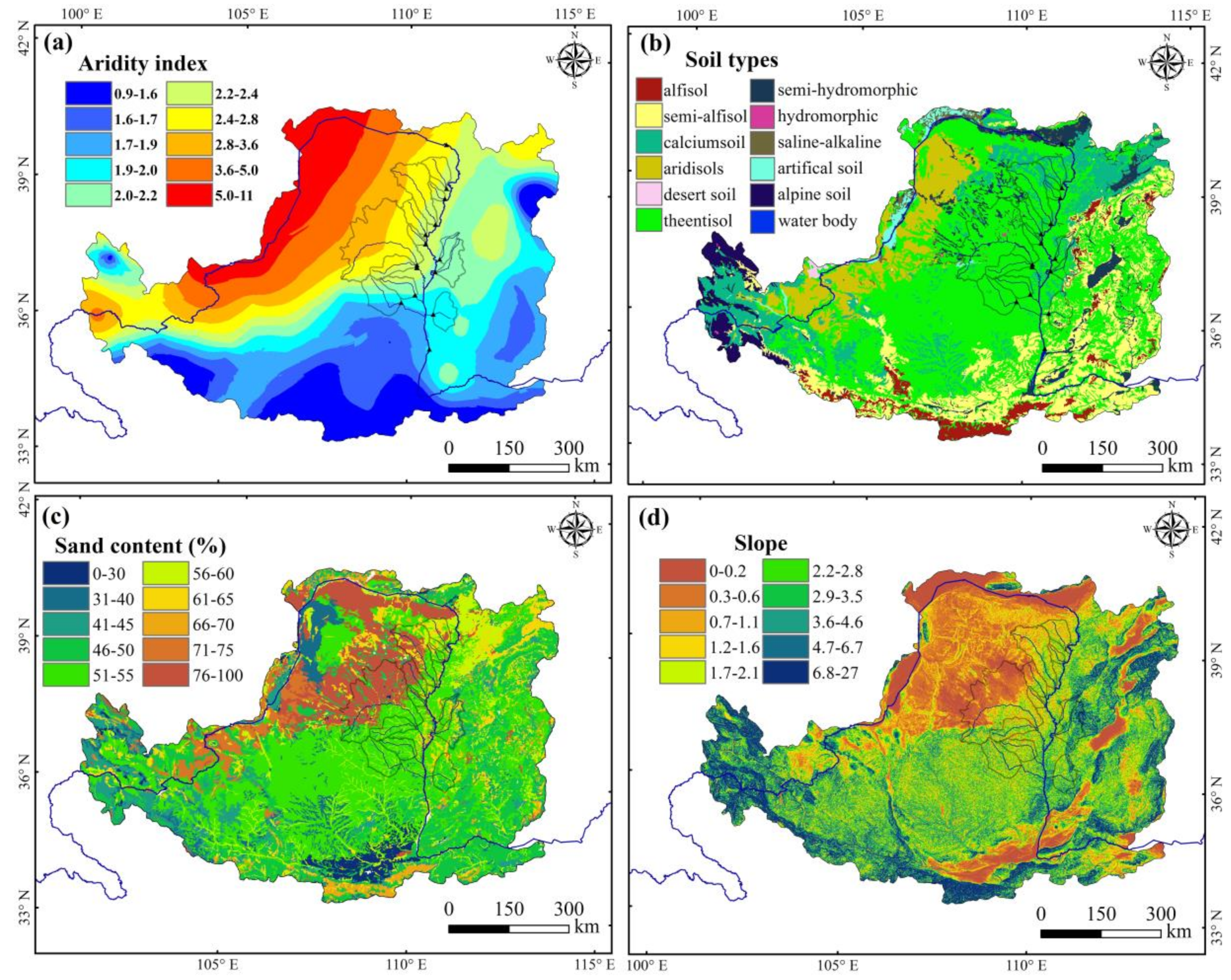
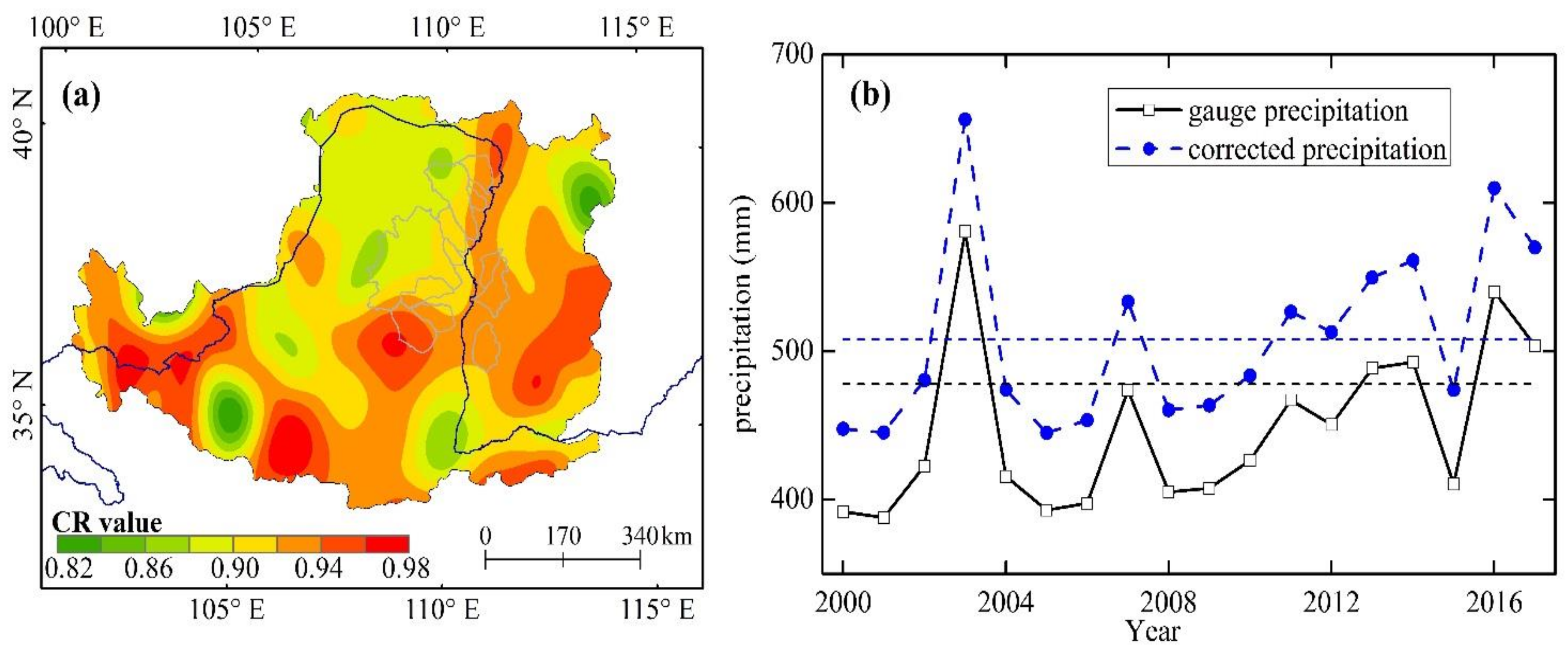

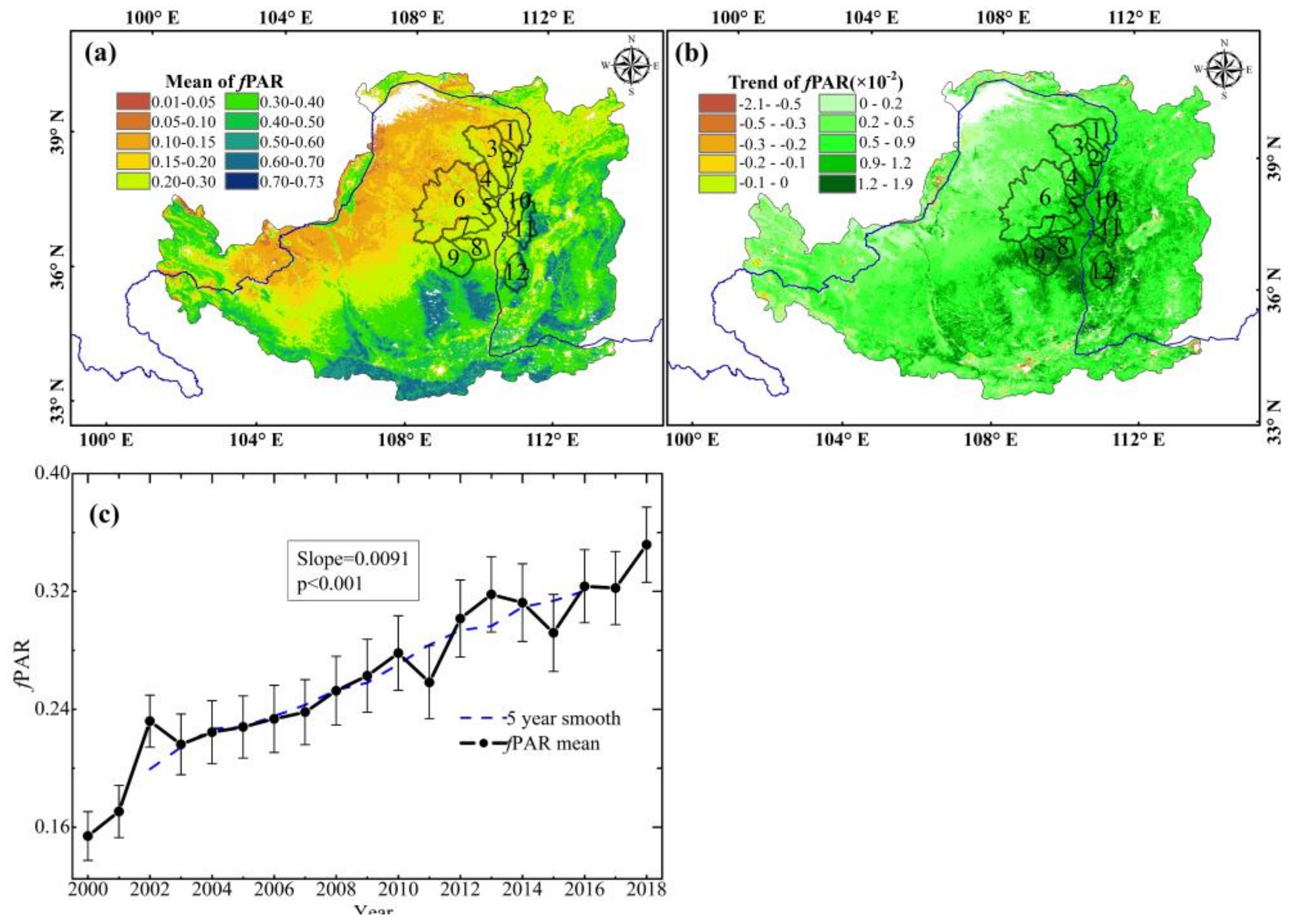
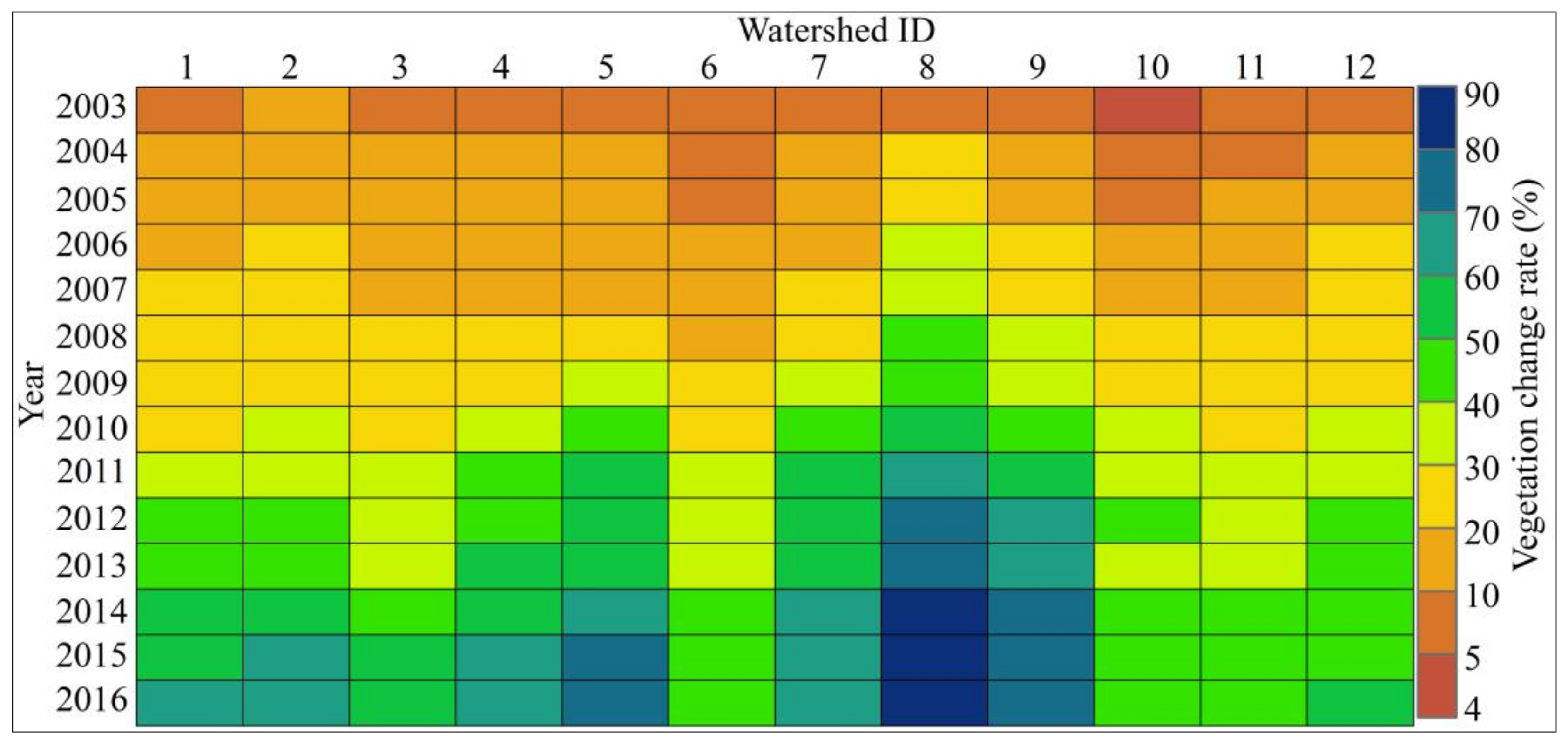
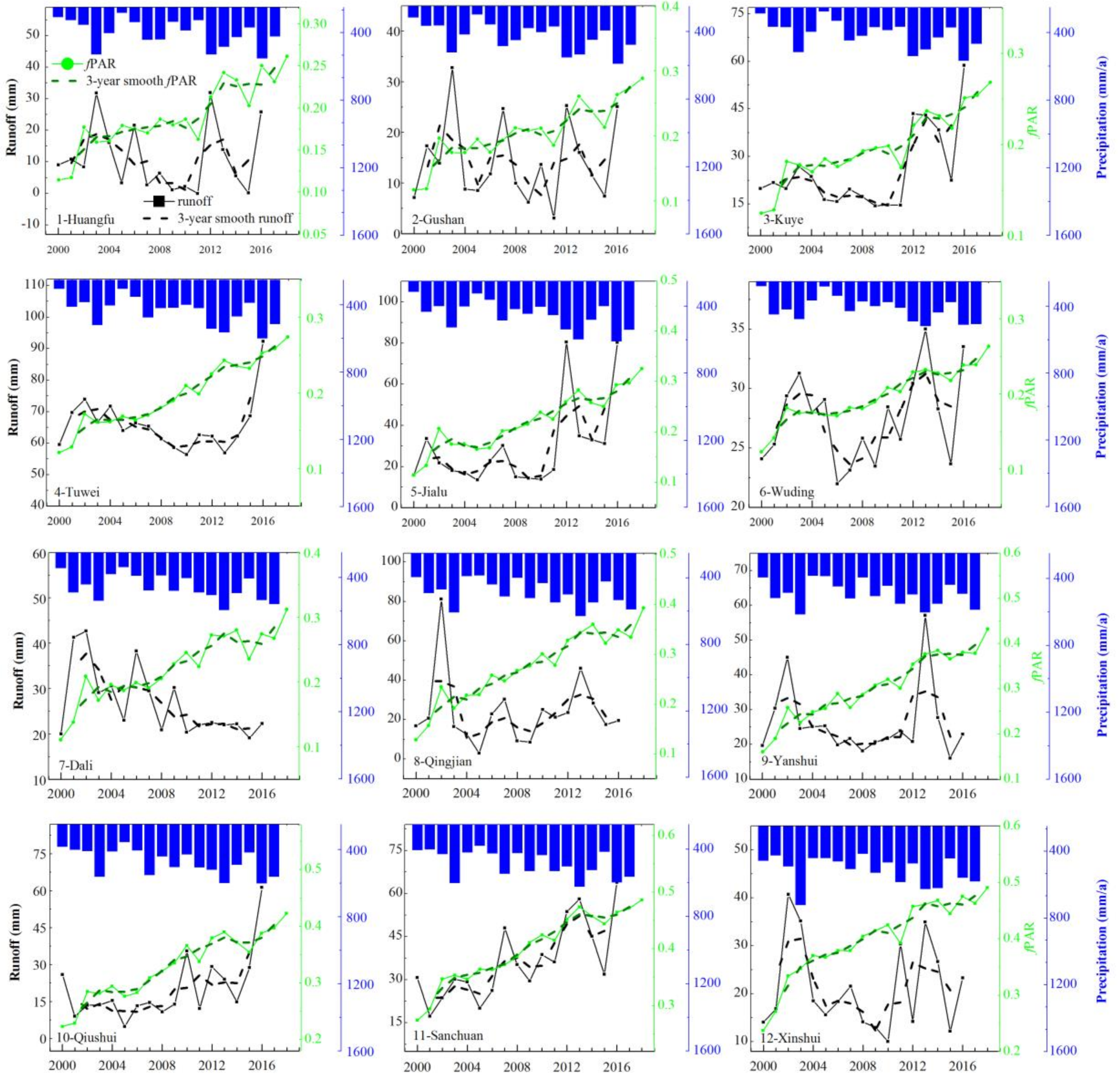
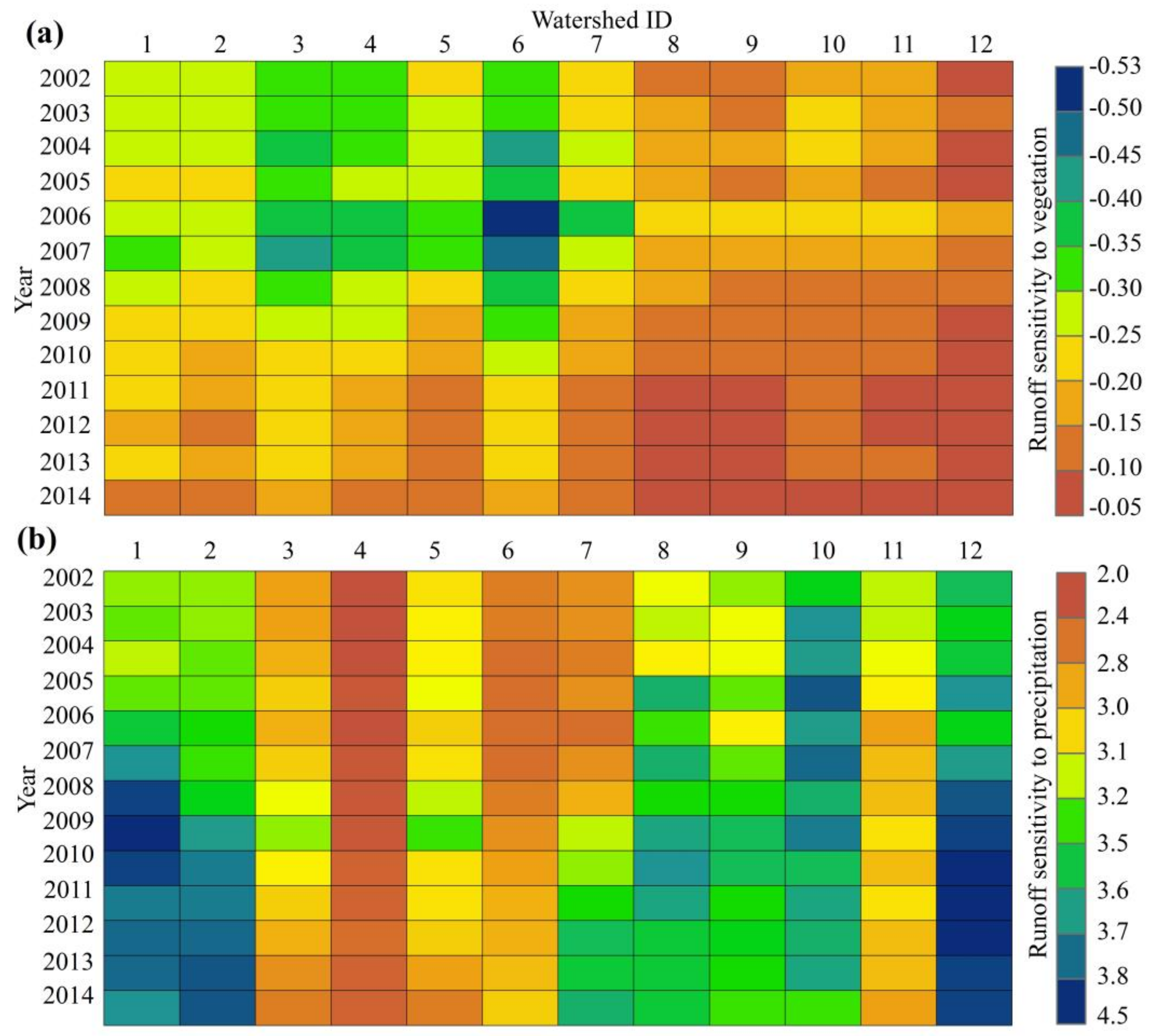
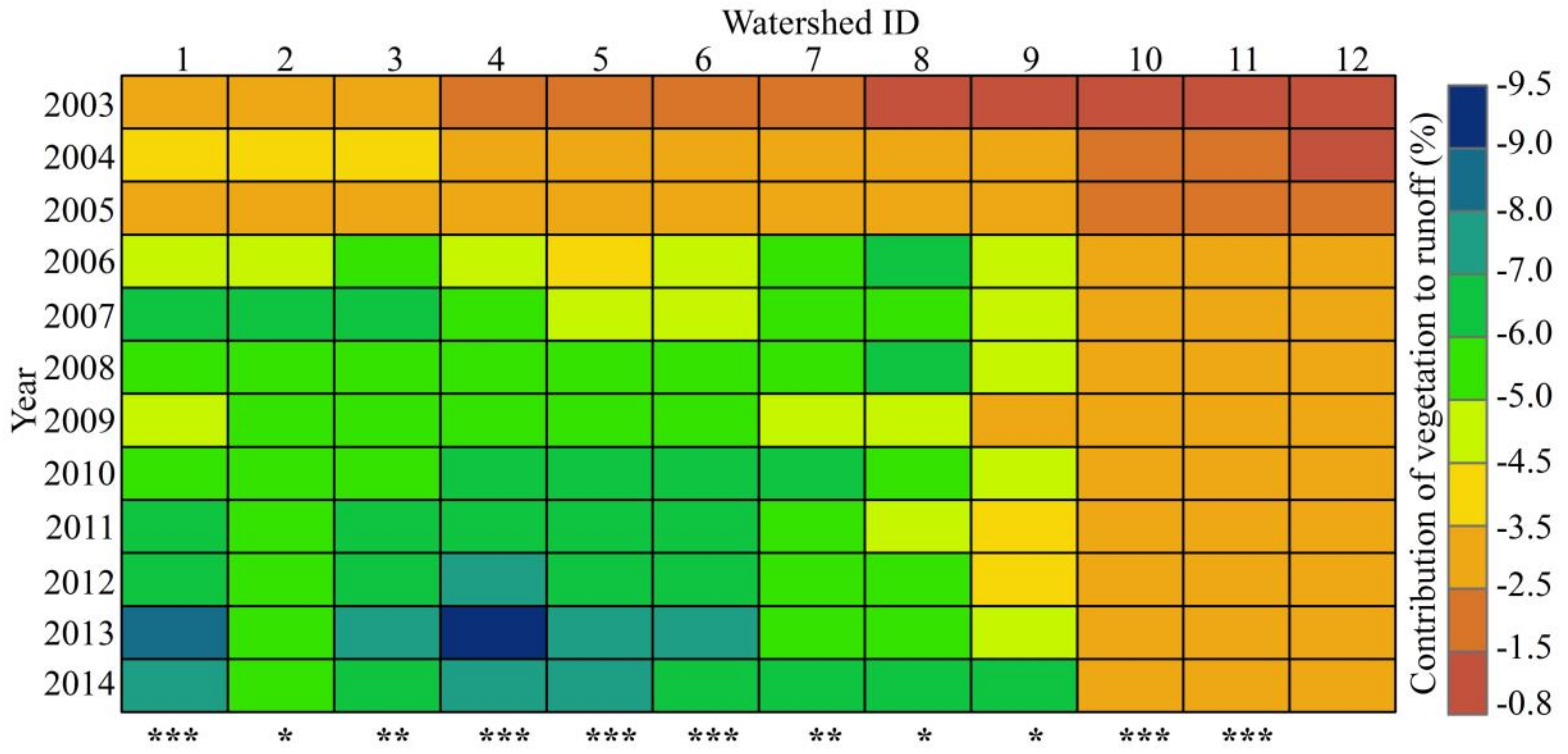
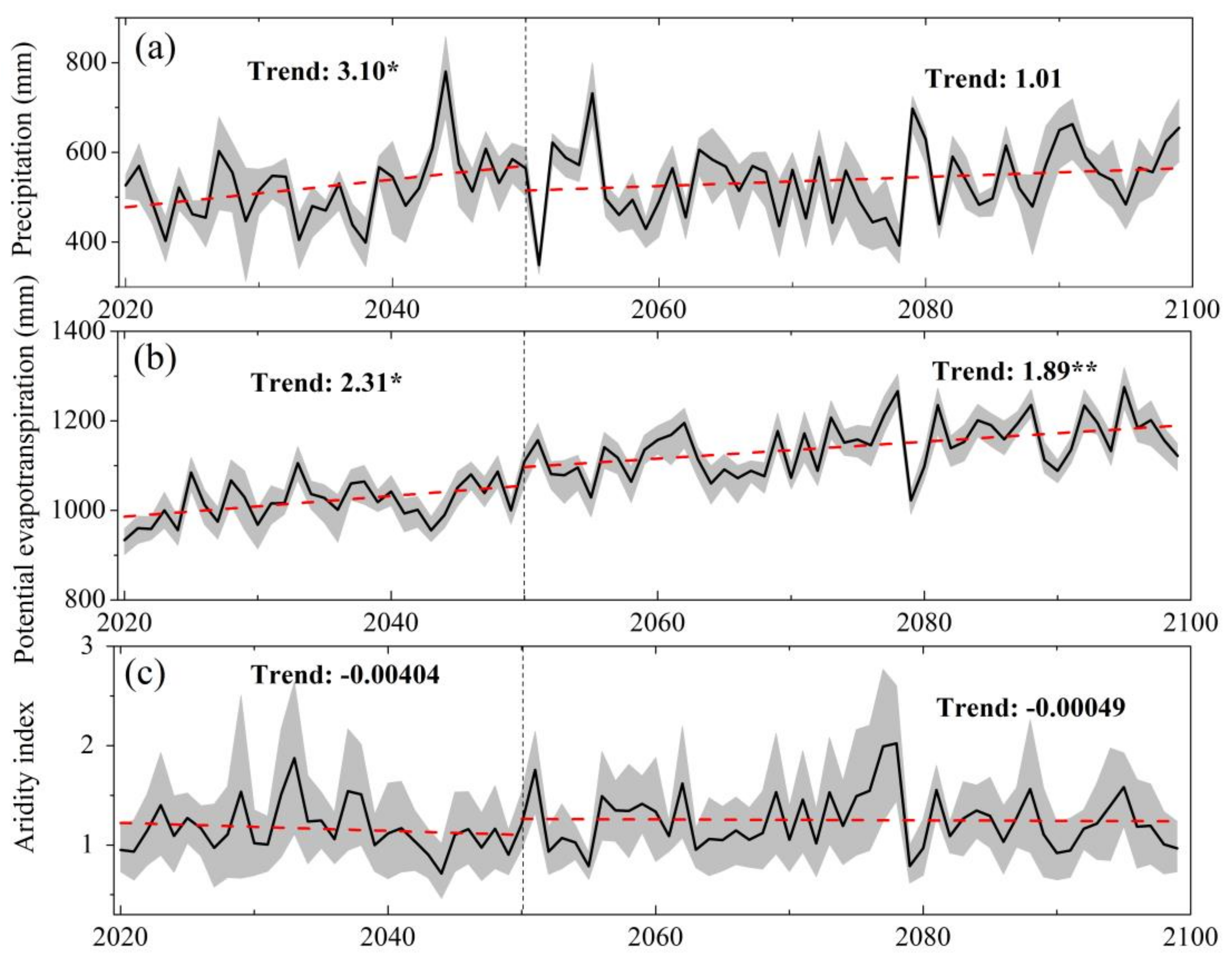
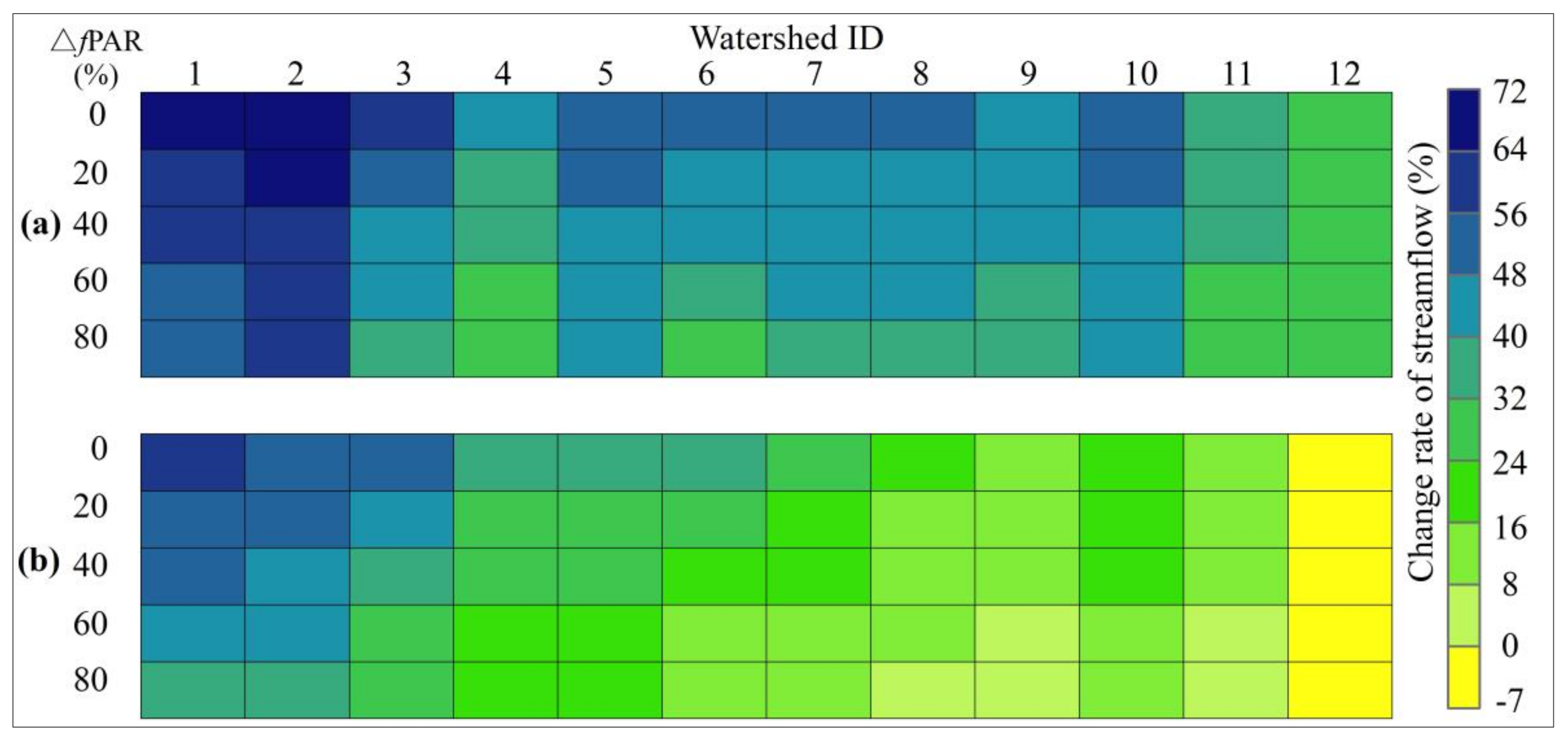
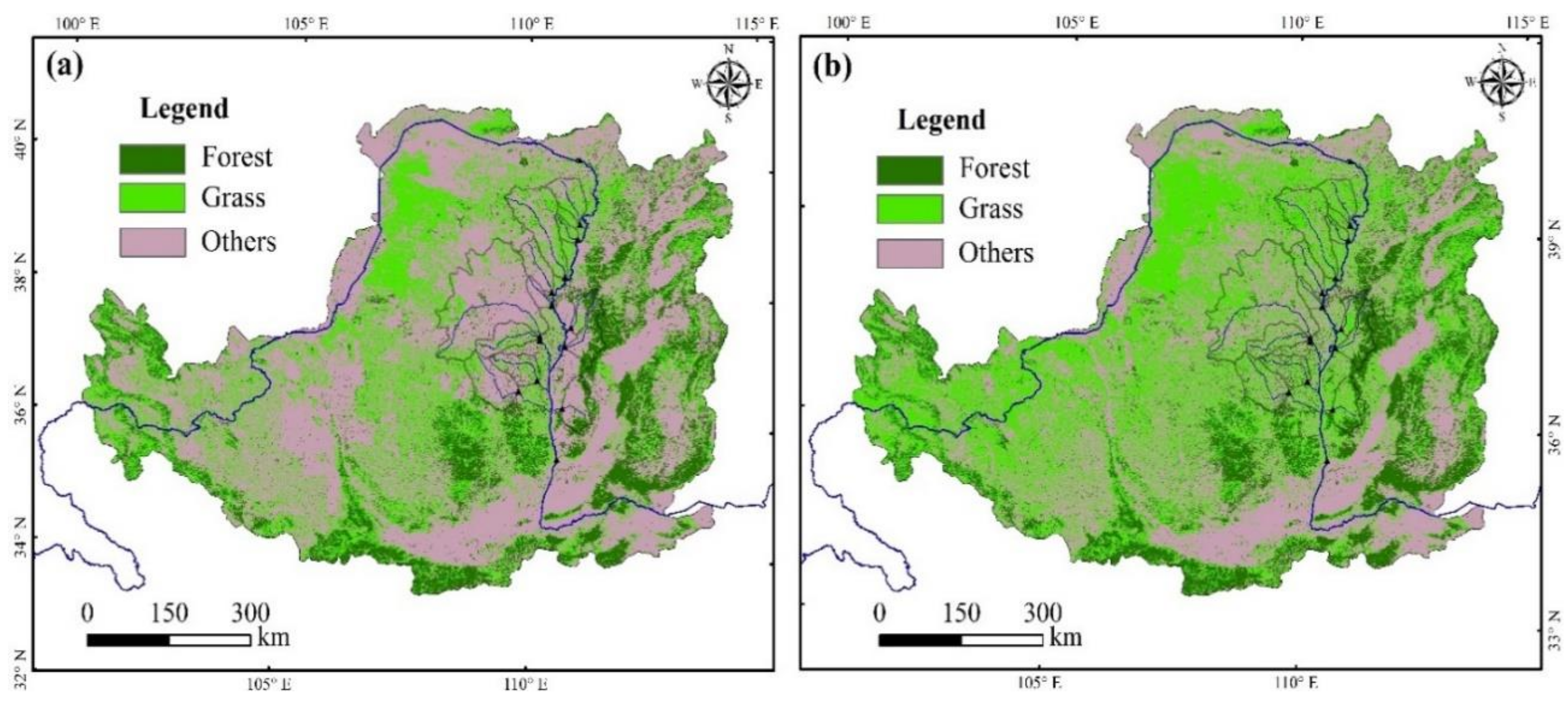
| Watershed ID | River Name | Hydrological Station | Area (km2) | Robs (mm) | Pre (mm) | PET (mm) | AI |
|---|---|---|---|---|---|---|---|
| 1 | Huangfu | Huangfu | 3175 | 11.22 | 402 | 981 | 2.44 |
| 2 | Gushan | Gaoshiya | 1263 | 14.29 | 428 | 988 | 2.31 |
| 3 | Kuye | Wenjiachuan | 8515 | 25.37 | 409 | 1021 | 2.49 |
| 4 | Tuwei | Gaojiachuan | 3253 | 65.79 | 436 | 1024 | 2.35 |
| 5 | Jialu | Shenjiawa | 1121 | 29.11 | 451 | 1024 | 2.27 |
| 6 | Wuding | Dingjiagou | 23422 | 27.45 | 411 | 1032 | 2.51 |
| 7 | Dali | Suide | 3893 | 27.13 | 457 | 1010 | 2.21 |
| 8 | Qingjian | Yanchuan | 3468 | 23.66 | 488 | 987 | 2.02 |
| 9 | Yanshui | Ganguyi | 5891 | 25.95 | 488 | 977 | 2.00 |
| 10 | Qiushui | Linjiaping | 1873 | 20.09 | 474 | 990 | 2.09 |
| 11 | Sanchuan | Houdacheng | 4102 | 36.32 | 484 | 977 | 2.02 |
| 12 | Xinshui | Daning | 3992 | 21.18 | 512 | 961 | 1.87 |
| Models | Modeling Center/Country | Spatial Resolution/Degree | Reference |
|---|---|---|---|
| BCC CSM1.1 | Beijing Climate Center /China | 2.81 × 2.79 | Xin, Wu [22] |
| BNU ESM | Beijing Normal University, China/China | 2.81 × 2.81 | Ji, Wang [23] |
| CanESM2 | Canadian Centre for Climate Modelling and Analysis/Canada | 2.81 × 2.79 | Chylek, Li [24] |
| GFDL-CM3 | National Oceanic and Atmospheric Administration (NOAA) Geophysical Fluid Dynamics Laboratory (GFDL)/USA | 2.50 × 2.00 | Griffies, Winton [25] |
| Types | Year | 1 | 2 | 3 | 4 | 5 | 6 | 7 | 8 | 9 | 10 | 11 | 12 |
|---|---|---|---|---|---|---|---|---|---|---|---|---|---|
| Forest | 2000 | 137 | 73 | 357 | 109 | 23 | 702 | 278 | 431 | 546 | 560 | 1854 | 1153 |
| 2015 | 164 | 76 | 457 | 111 | 32 | 908 | 329 | 671 | 706 | 559 | 1848 | 1154 | |
| change (%) | 19.7 | 4.1 | 28.0 | 1.8 | 39.1 | 29.3 | 18.3 | 55.7 | 29.3 | −0.2 | −0.3 | 0.1 | |
| Grass | 2000 | 1287 | 646 | 3423 | 530 | 56 | 3729 | 839 | 745 | 1009 | 308 | 288 | 218 |
| 2015 | 2083 | 637 | 5339 | 1459 | 520 | 10048 | 1434 | 1363 | 2594 | 762 | 978 | 1952 | |
| change (%) | 61.8 | −1.4 | 56.0 | 175.3 | 828.6 | 169.5 | 70.9 | 83.0 | 157.1 | 147.4 | 239.6 | 795.4 |
© 2019 by the authors. Licensee MDPI, Basel, Switzerland. This article is an open access article distributed under the terms and conditions of the Creative Commons Attribution (CC BY) license (http://creativecommons.org/licenses/by/4.0/).
Share and Cite
Li, Y.; Mao, D.; Feng, A.; Schillerberg, T. Will Human-Induced Vegetation Regreening Continually Decrease Runoff in the Loess Plateau of China? Forests 2019, 10, 906. https://doi.org/10.3390/f10100906
Li Y, Mao D, Feng A, Schillerberg T. Will Human-Induced Vegetation Regreening Continually Decrease Runoff in the Loess Plateau of China? Forests. 2019; 10(10):906. https://doi.org/10.3390/f10100906
Chicago/Turabian StyleLi, Yanzhong, Dehua Mao, Aiqing Feng, and Tayler Schillerberg. 2019. "Will Human-Induced Vegetation Regreening Continually Decrease Runoff in the Loess Plateau of China?" Forests 10, no. 10: 906. https://doi.org/10.3390/f10100906
APA StyleLi, Y., Mao, D., Feng, A., & Schillerberg, T. (2019). Will Human-Induced Vegetation Regreening Continually Decrease Runoff in the Loess Plateau of China? Forests, 10(10), 906. https://doi.org/10.3390/f10100906






